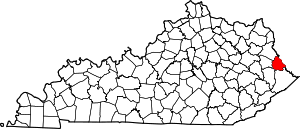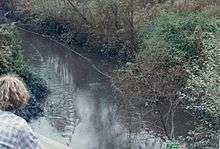Martin County coal slurry spill
The Martin County coal slurry spill was a mining accident that occurred after midnight on October 11, 2000, when the bottom of a coal slurry impoundment owned by Massey Energy in Martin County, Kentucky, broke into an abandoned underground mine below.[1] The slurry came out of the mine openings, sending an estimated 306 million US gallons (1.16 million cubic metres; 1.16 billion litres) of slurry down two tributaries of the Tug Fork River. By morning, Wolf Creek was oozing with the black waste; on Coldwater Fork, a 10-foot-wide (3.0 m) stream became a 100-yard (91 m) expanse of thick slurry.


The spill, which contained arsenic and mercury, killed everything in the water.[2] It was over five feet deep in places and covered nearby residents' yards. The spill polluted hundreds of miles (200–300 mi or 300–500 km) of the Big Sandy River and its tributaries and the Ohio River. The water supply for over 27,000 residents was contaminated, and all aquatic life in Coldwater Fork and Wolf Creek was killed. The spill was 30 times larger than the Exxon Valdez oil spill, spilling 12 million US gallons (45,000 cubic metres; 45 million litres). It was one of the worst environmental disasters ever in the southeastern United States, according to the United States Environmental Protection Agency (EPA).[3] In 2001, the EPA ordered Massey Energy to clean up and restore the damaged areas of Martin County.[4] The EPA took measures to investigate this site, and make restoration plans.[5] A decade later, there are still water quality issues in Martin County; people are still finding sludge and slurry in their surface waters, such as streams.[6]
The spill was exceeded in volume by the Kingston Fossil Plant coal fly ash slurry spill in 2008. Since this spill, the Mine Safety and Health Administration has made efforts to prevent this from happening in the future by implementing new slurry pond regulations. A few of MSHA's efforts include increasing training for staff, and requiring mining engineers to perform thorough investigations of mining impoundment areas.[7]
Furtiveness surrounding disaster
U.S. Secretary of Labor Elaine Chao, wife of Senator Mitch McConnell (R-Ky.), oversaw the Mine Safety and Health Administration (MSHA) at the time. In 2002, a federal penalty of $5,600 (equivalent to $8,000 today) was levied against Massey Energy, and was subsequently paid.[8] When the Bush administration came into power, they cut the investigation short, as Massey Energy was a generous contributor to the Republican Party.[9][10] In addition, the Bush presidency aimed to expand energy production and resources in the US, and therefore relaxed regulations.[11][12]
Whistleblowing
Jack Spadaro,[13] a whistleblower who worked in natural resources and mining,[14] was one of the lead investigators that looked into the spill. He reported evidence that showed the administration and the engineers who were to be looking out for the best interests of people were aware of another spill in the same area from 1994 on, but they had never released the information to the public and had instead covered it up.[15]
Specifically, Spadaro argued that the Bush administration was covering up the Martin County spill. Spadaro complained that the new administration had given lucrative contracts for work at the National Mine Health and Safety Academy to friends, and that the MSHA was divided into 186 smaller contracts. The MSHA denied the accusations.
On June 4, 2003, government agents began sifting through Spadaro's documents in his office. He was locked out and placed on involuntary administrative leave. Eventually the investigation was closed and Spadaro's evidence was discarded.[16]
References in popular culture
In 2005 Appalshop filmmaker Robert Salyer released a documentary entitled Sludge, chronicling the continuing story of the Martin County disaster, the resulting federal investigation, and the looming threat of coal slurry ponds throughout the coalfield region. In the wake of the Kingston Fossil Plant coal fly ash slurry spill, Appalshop provided a web stream of Sludge for a limited time.[17]
See also
- Buffalo Creek Flood
- Mountaintop removal mining
References
- Sealey, Geraldine (October 23, 2000). "Sludge Spill Pollutes Ky., W. Va. Waters". ABC News. Retrieved June 6, 2014.
- "A Toxic Cover-Up?".
- Sludge: a documentary by Robert Salyer Archived January 7, 2013, at the Wayback Machine Retrieved June 6, 2014.
- McSpirit, Stephanie. "Epa Actions in Post Disaster Martin County, Kentucky: An Analysis of Bureaucratic Slippage and Agency Recreancy". EBSCOhost. Journal of Appalachian Studies. Retrieved April 25, 2019.
- "Martin County Work Plan" (PDF). EPA.gov. Environmental Protection Agency. Retrieved April 25, 2019.
- Becker, Benny (January 27, 2017). "Troubled Waters: A Coal County Loses Trust in Water and Government". Ohio Valley Resource. Retrieved April 25, 2019.
On any given day in Martin County, Kentucky, the water system loses more water to leaks than it delivers to paying customers through their faucets. The water system is under a state investigation for the third time since 2002. Customers complain of frequent service interruptions and discolored water, and their bills come with a notice that drinking the water could increase the risk of cancer.
- Lovan, Dylan (October 15, 2010). "After Decade, Still Signs of Coal Slurry Spill". The Washington Post. Retrieved April 25, 2019.
- "Toxic coal sludge pollutes Ky. town 10 years later". Associated Press. March 27, 2015. Retrieved April 28, 2019.
- "A Toxic Cover-Up?".
- "Before the Blankenship-McConnell Feud, the Senator Aided the Mining Executive — ProPublica". ProPublica. Alec MacGillis. May 7, 2018. Retrieved May 7, 2018.CS1 maint: others (link)
- "Energy for America's Future". georgewbush-whitehouse.archives.gov. Retrieved July 30, 2018.
- Scott, Shaunna L.; McSpirit, Stephanie M. (2017). "The Martin County Coal-Waste Spill: Reflections and Suggestions". In Lee, Brian D. (ed.). Water in Kentucky: Natural History, Communities, and Conservation. University Press of Kentucky. pp. 73–80. ISBN 978-0-8131-6870-8. JSTOR j.ctt1pd2kxw.
- "Audubon: Incite". December 9, 2006. Archived from the original on December 9, 2006. Retrieved April 28, 2019.
- "A Toxic Cover-Up?". www.cbsnews.com. Retrieved April 28, 2019.
- BRYANT, ANNIE; JAMISON, PHIL; JENKINS, CARL; PEPPER, SUSAN; WEINSTEIN, LEILA; BEAVER, PATRICIA D.; Spadaro, Jack (2007). "Interview with Jack Spadaro: On Being a Whistleblower for Mine Safety and Health". Appalachian Journal. 34 (3/4): 326–350. JSTOR 40934637.
- Babich, Phillip (November 14, 2003). "Dirty business". Salon. Retrieved June 12, 2019.
- "Archived copy". Archived from the original on January 6, 2009. Retrieved December 31, 2008.CS1 maint: archived copy as title (link)